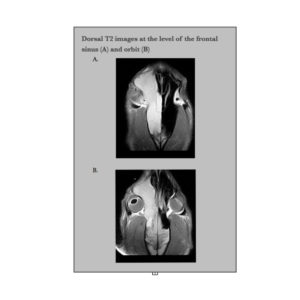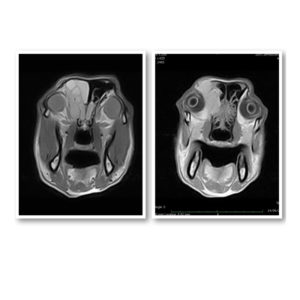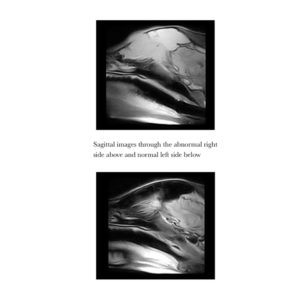Alfie the Airdale Terrier
The Tip of the Iceberg
Alfie is an 8 and a half year old male neutered Airdale Terrier. He had a 6 month history of right sided conjunctivitus and epiphora. In the last week or two, a small swelling formed over the medial canthus that was mildly painful on palpation. An MRI was requested to include the sinuses, orbit, nasal cavity and brain.

Findings
There is a large amount of relatively homogenous tissue occupying the entire right frontal sinus and extending through the sinus into the nasal cavity and orbit. There is frontal, maxillary and ethmoid bone destruction while the cribriform plate appears intact.
The central portion is hypointense on T1 with no contract enhancement and hyper- to hypointense on T2. The material within the frontal sinus is hyperintense relative to that in the nasal cavity. There is a thin outer rim which shows mild contrast enhancement.

Differential Diagnoses
Frontal sinus myxoma, myxosarcoma, mucocoele, zygomatic, sialocoele, carcinoma, abscess.
Cytological evaluation of a fine needle aspiration biopsy showed a mixed cell inflammatory picture as well as occasional groups of epitheliod cells that were relatively uniform in appearance. Although there was no clear evidence of malignancy, the epitheliod cells were considered suspicious. Surgical biopsies were offered but declined by the owners.

The mass continued to grow slowly over the following months to where it was causing significant discomfort and displacement of the globe. The owners the agreed to surgical biopsy 3 months after the MRI examination. Surgical exploration showed progression of the mass with destruction of the cribriform plate and extension into the olfactory bulbs of the brain. Alfie was euthanised. Biopsies confirmed a sinonasal carcinoma.
Nasal and paranasal sinus tumours account for approximately 1% of all neoplasms in dogs. Most of these are carcinomas which spread by local invasion. Metastasis may occur however, most commonly to the local lymph nodes and lung. Definitive diagnosis requires tissue biopsy. Invasion of bone occurs early in the disease and curative surgery is virtually impossible.
Radiation therapy is currently the treatment of choice for this disease.
Author
